Fresh Proof of the Existence of Planet Nine in Our Solar System
Are there any planets still to be discovered lying in the outer space of our solar System?Maybe it could be happily orbiting the Sun in the region of comets and the icy things. As some scientists have proved, the answer is definitely yes.
The Planet Nine (P9) idea has been in existence since 2016 when astronomers Mike Brown and Konstantin Batygin have provided the evidence of its existence. Thus, these people and their colleagues have since then published more research to add more support to the idea of P9.
Many pieces of evidence have been brought out which support the P9, but none of them has yet reached the level of definitive proof. The principal evidence is about the unusual orbits of Extreme Trans-Neptunian Objects (ETNOs), which are in a cluster and hence, the existence of a huge celestial body is suggested. It is certain that P9 is the one that steers these objects along their orbital paths.
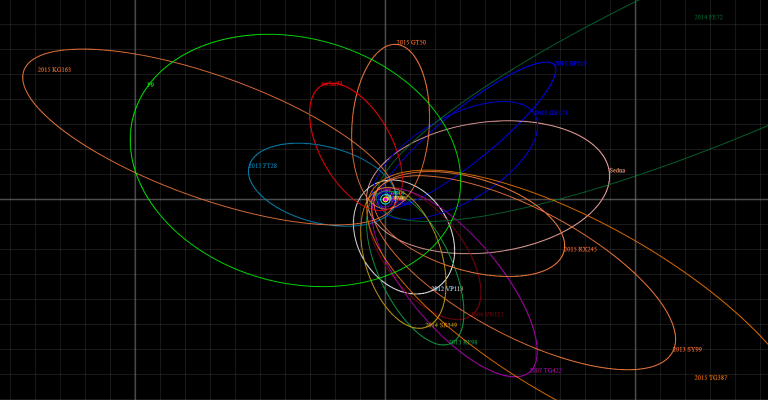
The Caltech astronomers Brown and Batygin are among the most notable participants in the study of P9. In their latest article, they, together with their partners Morbidelli and Nesvorny, give more proof to prove the existence of P9. The paper, entitled “Production of Low-Inclination, Neptune-Crossing TNOs by Planet Nine,” was published in The Astrophysical Journal Letters.
The authors illustrate the odd dynamical structure of the remote areas of the solar system, which proves the existence of a huge trans-Neptunian object like Planet Nine. The earlier studies that have already proved how the orbital evolution caused by this imaginary object can be the reason for the origin of the most peculiar orbits have
been confirmed.
Through the in-depth investigation done by Batygin, Brown, Morbidelli, and Nesvorny, the scientists were able to study the Trans-Neptune Objects (TNOs) that have normally, or usually, orbits and had more ordinary TNOs. Their N-body simulations considered the gravitational influence of the big planets, the Galactic Tide, the gravitational effect of passing stars and also some other factors.
Out of the 29 objects in the Minor Planet Database that have an orbit well-characterized or body greater than 100 astronomical units, inclinations below 40 degrees, and perihelia distances below 30 astronomical units, the researchers concentrated on the 17 objects with a well-quantified orbit in the simulations.
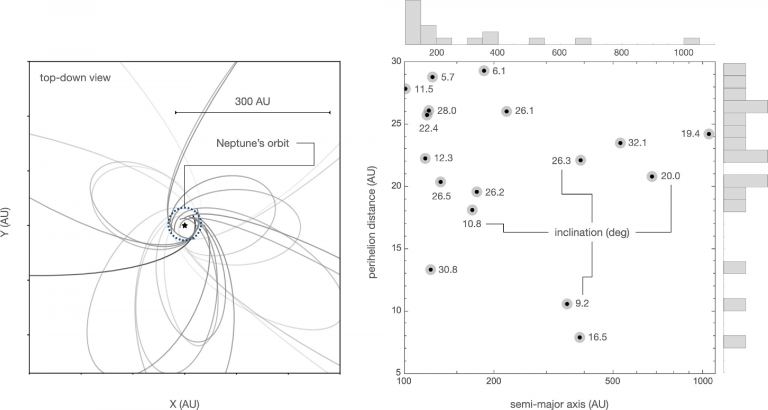
The researchers were interested in the study of the objects’ origin and to find their possible use as a probe for P9. Thus, they performed two entirely different simulations which were both designed for the very same aim. There were two sets of results; one was P9 being in the Solar System and the other was not.
The simulations started at the time t=300 million years, which is equal to 300 million years after the formation of the Solar System. While this time the authors describe that the baseline intrinsic dynamical evolution in the outer solar system was still in its beginning stages. After the time of the Solar System’s birth cluster of stars was passed, the dispersion of the cluster of stars had already been completed and the giant planets had mostly finished their migrations. The simulation with perihelion greater than 30 au and semimajor axes between 100 and 5000 au gave the result of 2000 objects or particles. This choice of the initial conditions of the simulation had all the Neptune-crossing objects in it but the Neptune-crossing objects were not there in the beginning of the simulation. The researchers stress the fact that the initial conditions that were chosen are closely connected to the assumed orbit of P9.
The picture below shows the progress of the evolution of a part of the 2,000 objects from the simulations.
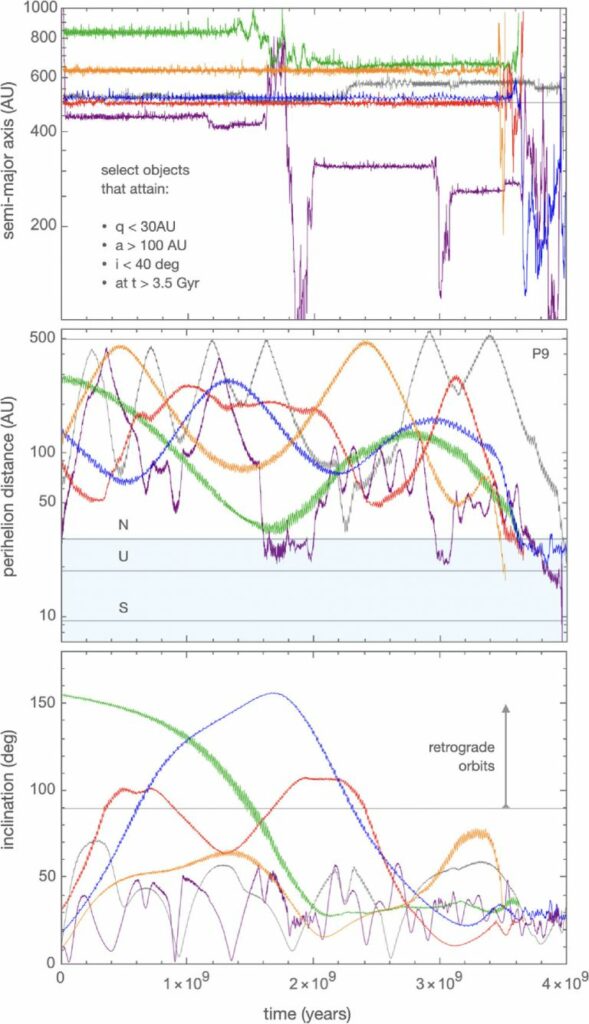
These findings are interesting; still the researchers remind us that they do not give us conclusive proof of the existence of P9. The orbits might be due to some other factors which can be the Galactic Tide. Moving on, the following research was mainly aimed at the investigation of the isotropy of perihelion in their study.
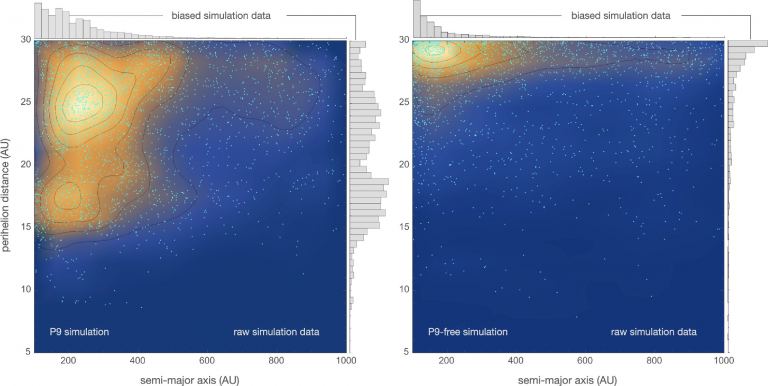
The authors of the research underline that the reasons other than P9 might be the ones that explain the rare orbital patterns seen. They propose that the objects may have been affected by cluster dynamics when they were created, or by Earth-mass rogue planets that have later been removed from the Solar System.
Nevertheless, the authors carefully chose the 17 Trans-Neptunian Objects (TNOs) for their study because these objects have chaotic orbits and short lifetimes and thus, emit most of their energy before they are destroyed. This, in turn, implies that the forces that are currently pushing these objects into their orbits are still operating and not a mere relic of the past.
The most important result of this research is to find the testable predictions. The authors mention that the dynamics that they studied, together with other evidence for P9, will soon be soon put to the test with the start of the operations at the Vera Rubin Observatory (VRO). This is a great chance to continue to the research they conducted and to confirm their results.
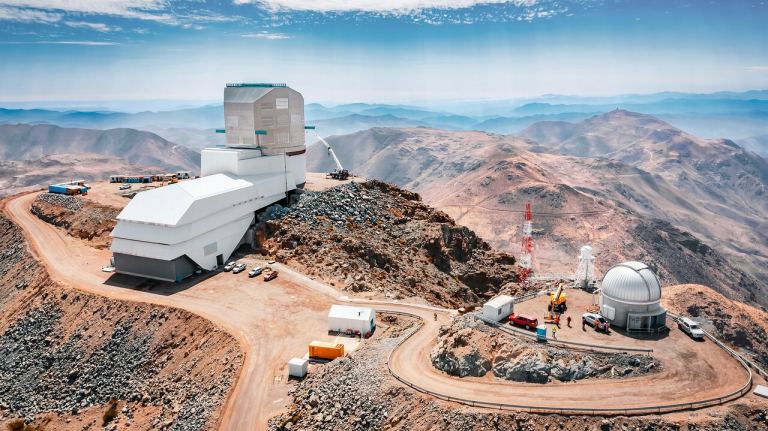
If P9 is proven to be real, its identity is still unknown. It might have been the core of a huge planet that was thrown away by the process of the early stage of the Solar System. It could also be a drifting planet that roamed through the interstellar space before it got caught up by our Solar System’s gravity. Alternatively, it was created in a distant orbit and then its current hilly path was formed by a passing star which drove it into that path. After the confirmation of the existence of P9, the following question will be what is its real value.
The situation of P9 gives us very useful informations on the principles of scientific investigation. In the field of modern astronomy, it is normally impossible to find a significant discovery. As opposed to that, the fact evidences collect gradually, which leads to debates and counterarguments. Objections are brought up, inconsistencies are discovered, and methods are improved as the rushing knowledge moves forward. At first, it seems to be one big question, but it is then broken down into several small, easier to deal with questions.
Despite the ongoing process of scientific investigation, the central question remains: Is it real or is it just a figment of our imagination?
Do not forget to share your opinion with us to provide you with the best posts !



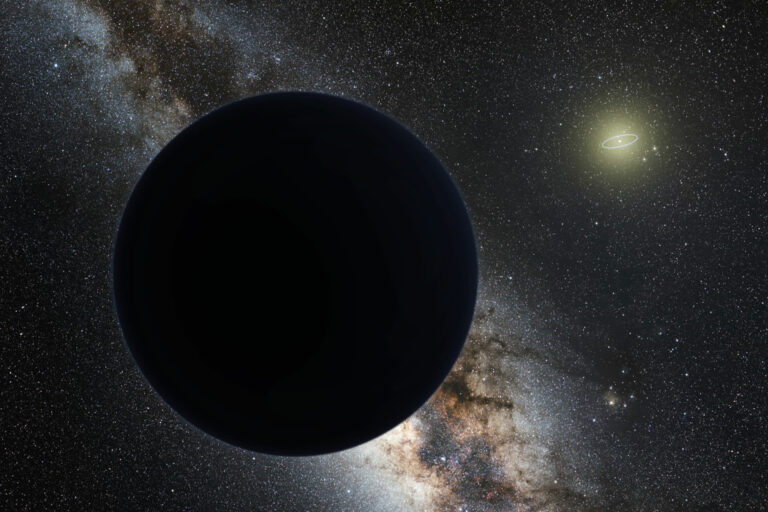
0 Comments